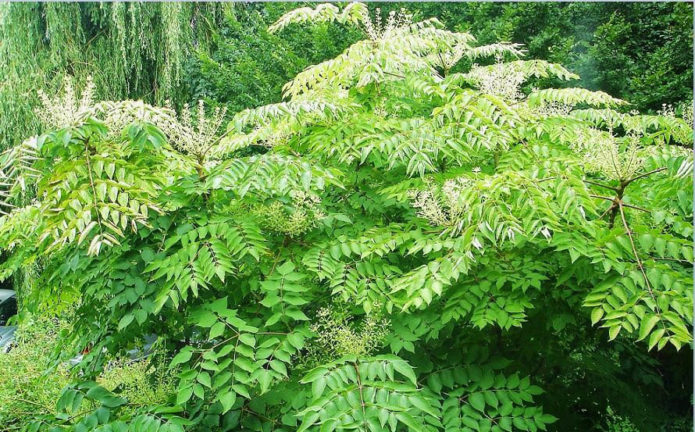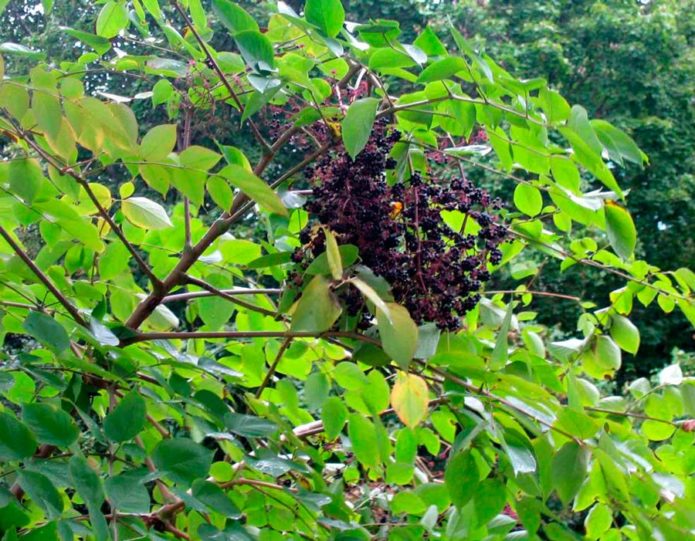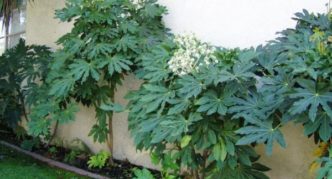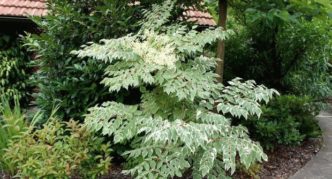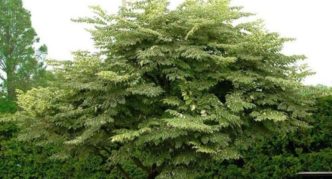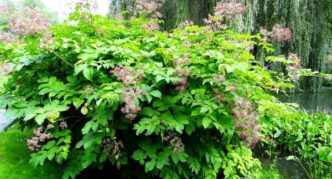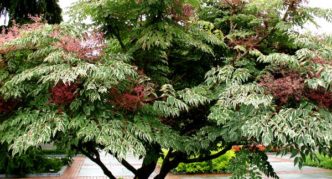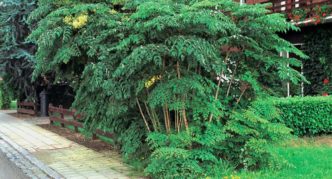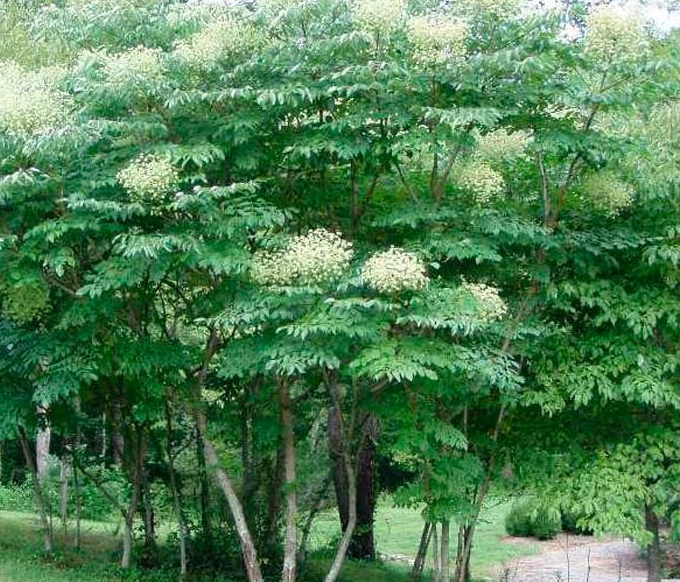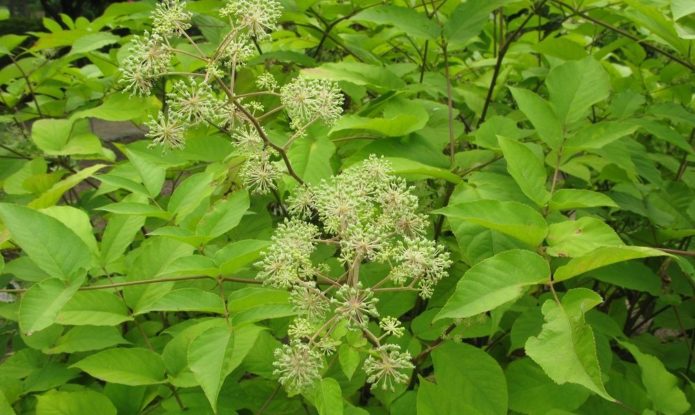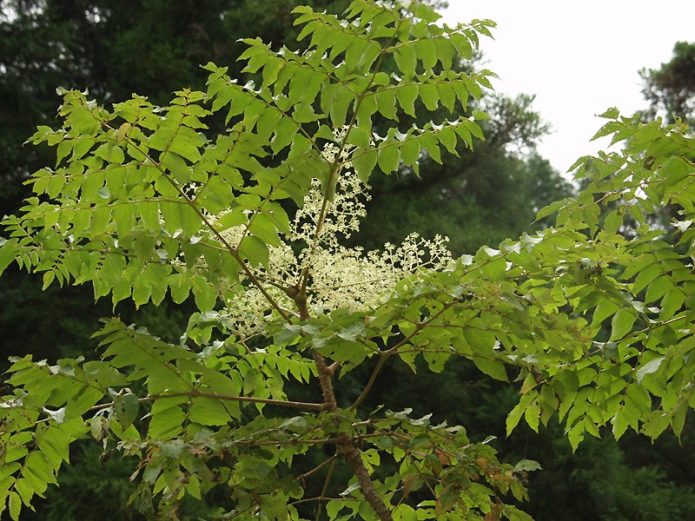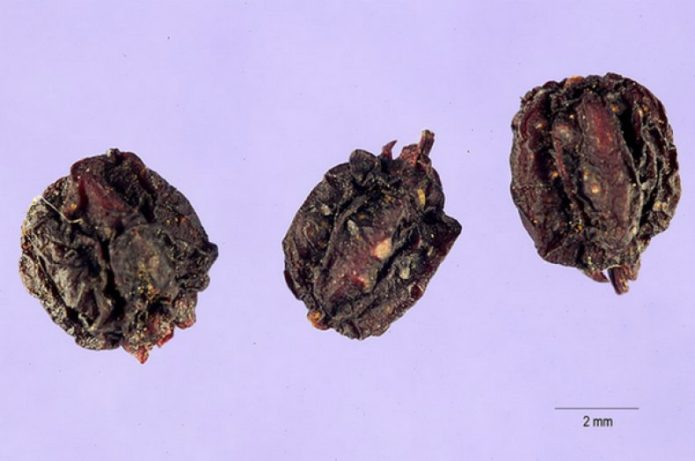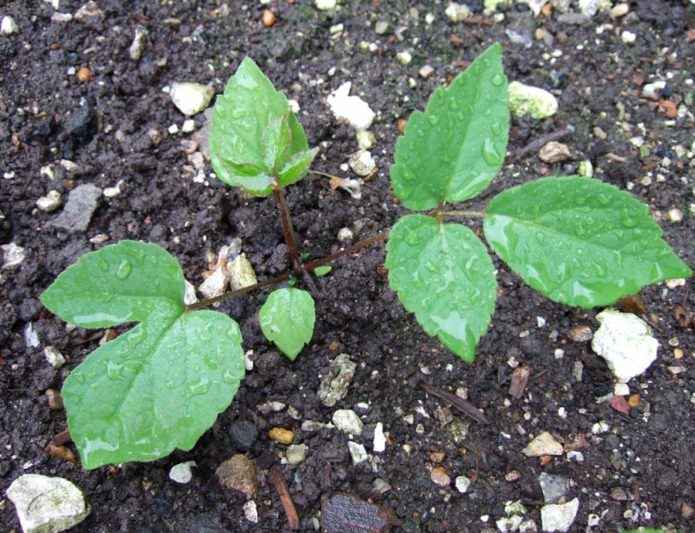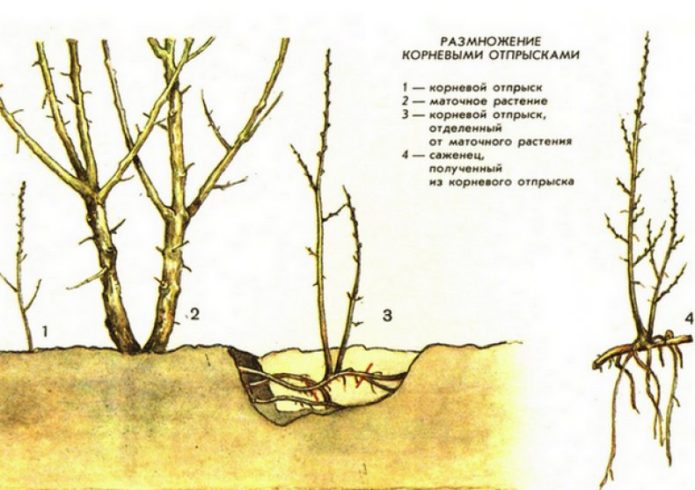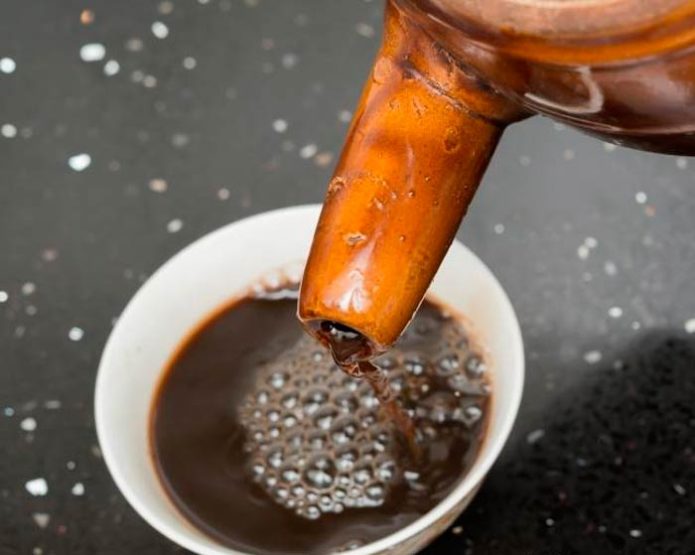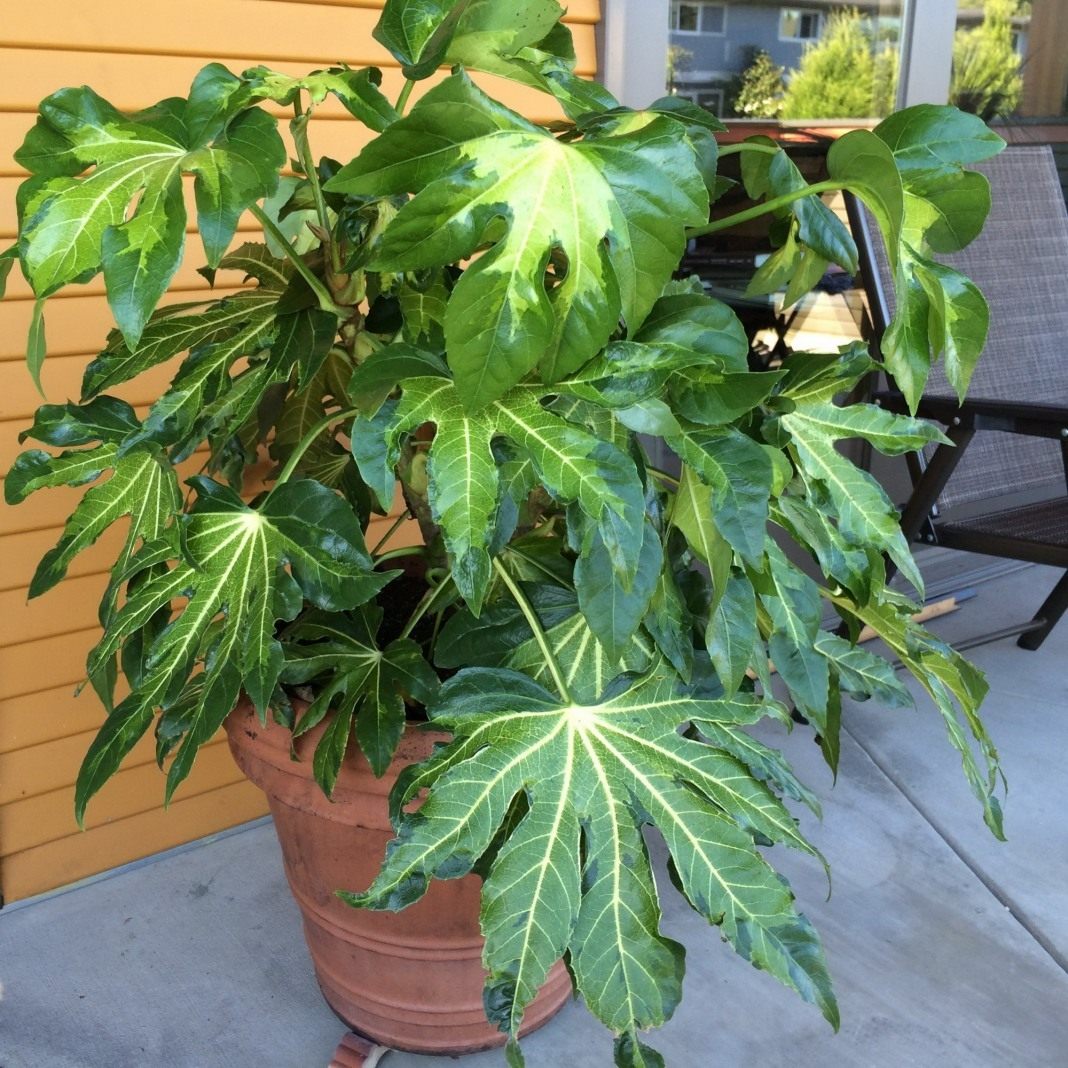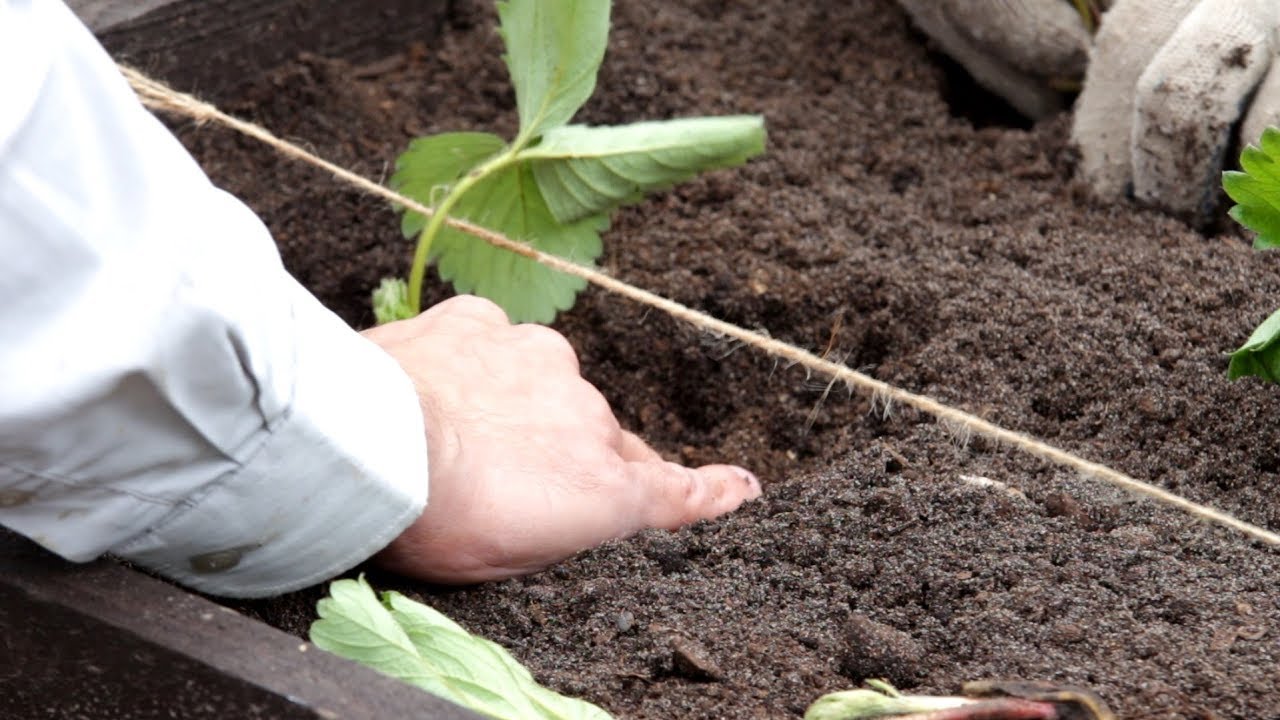Aralia is a deciduous herb from the genus of flowering Araliev family. It is popularly called "devil tree" or "thorn tree", which is due to the thorny stem. It can be in the form of a branchy shrub or tree. In the gardens, Manchu Aralia is mainly cultivated for decorative and medicinal purposes. In total, there are up to 70 species in nature.
Content
What is interesting in Aralia and where is the tree grown
In its natural environment, Aralia grows mainly in the Far East. In central Russia, it is cultivated artificially. The plant is extremely hardy and unpretentious, therefore it does not need special care. Mature trees can endure freezing temperatures, but in a frost of -30 ° C they can freeze to the root collar, however, then they quickly recover with warming. Young seedlings up to 3 years old are best insulated and mulched for the winter period, since they may die due to temperature jumps.
For the first time, Aralia blooms only in the fifth year after planting and this period lasts from July to September. After that, blue-black fruits in the form of berries are formed on it.
For planting aralia in a personal plot, a plot is selected where there is a lot of light for about 12 hours. It is desirable that there is shading, which is especially important to protect the plant from the midday heat. With prolonged exposure of the Aralia under the influence of direct sunlight, burns on the leaves are possible. The soil for aralia is preferable loose, nutritious and with an acidity index of 5 to 6 pH. In clay soil, moisture stagnates and the roots of the plant are inhibited in development. To dilute such a soil, it is recommended to add sand when digging (1 bucket per sq. M.).
Aralia is moisture-loving, but does not tolerate stagnant water. Therefore, its location should not be in lowlands or near water bodies. It is also undesirable to plant a shrub along the garden paths, since over time the culture grows strongly and becomes an obstacle to movement.
Video: plant description
Application
Due to its rapid growth and decorative appearance, aralia is actively used in landscape design to decorate the territory. It has unusual foliage (feathery), reminiscent of a palm tree. Its color changes depending on the season: in the spring - gray-green, in the summer - rich emerald, in the fall - pink-purple (sometimes with a red tint). And when flowering, the plant is covered with small fragrant creamy-white buds, which are collected in lush clusters. They attract not only people but also bees.
Thanks to its thorny shoots, Aralia is often grown as green fences. It looks impressive both in compositions and alone near a house or other buildings.When it is adjacent to other horticultural crops, it is necessary to prune in a timely manner so that it does not displace them.
Aralia, in addition to its decorative function, is also useful. Thanks to its tonic properties, people near the tree stabilize their blood pressure and quickly recover their strength.
Aralia in the garden: examples of application in landscape design (photo)
- Aralia forms a high "hedge" in a short period of time
- It is better to plant aralia Manchu away from garden paths so that it does not interfere with movement
- The tall aralia tree can reach heights up to 20 m
- Aralia bush literally in 4-5 years can turn into a three-meter tree
- After flowering, clusters of poisonous fruit-berries appear on the aralia
- It is better to plant prickly aralia along the alleys, which has long shoots
Types and varieties of aralia with photo
In addition to high or Manchu aralia, other species are grown in the regions of the middle lane:
- Aralia prickly is a deciduous tree that grows in nature up to 15 m in height, and in culture it is found only in the form of a shrub. It has thin, lignified stems, studded with long thorns at an early age. Its shoots are also thorny green. The plant has feathery leaves up to 80 cm long, attached to petioles. Their outer side is green, the inner side is gray. The first 3-4 years the bushes grow especially intensively, then slow down. This representative is more frost-resistant than others.
- Aralia Schmidt or heart-shaped is a two-meter tall herbaceous perennial with stiff bare stems and a fragrant thick rhizome. Its leaves are double-pinnate, about 50 cm long. It blooms with apical inflorescences in the form of panicles, consisting of small brownish-yellow or greenish flowers.
- Chinese Aralia - Representative found in China, Vietnam and Malaysia. It is a thorny branchy bush or a compact tree eight meters high. It has light emerald leaves 40-50 cm long with serrated edges and a pointed tip. On the reverse side, they are pubescent. The plant blooms with lush white inflorescences, then fruits with a diameter of up to 3-4 mm are formed.
- Aralia continental is a Far Eastern variety of a meter in height with a spherical crown consisting of carved leaves. Above, the leaf plates are glossy, covered with short hairs from the inside. Her inflorescences are creamy.
Hybrid varieties of Manchurian aralia:
- Subinermis is a specimen whose shoots are less prickly or even bare.
- Pyramidalis is a pyramidal plant with compact leaves.
- Canescens is a variety with yellow terry on the outside of the leaves.
- Aureo-variegata is a spiny aralia up to three meters high and a crown about 2–2.5 meters in diameter. Her leaves are small with spots on the outside and a light border. In the fall, it is dyed scarlet.
- Variegata is a slow-growing plant about three meters high. Its leaves are openwork of a white-silver hue and up to 100 cm long.
Landing in the ground
Aralia is planted in open ground in spring, when the soil warms up to a temperature of +5 ° C and sap flow has not yet begun. If planting is carried out in the fall, then the best time is after leaf fall. Before planting, the site is thoroughly cleaned of garden waste and pests (slugs, May beetle, bear and others). To do this, dig up the soil and leave it for at least a week for airing. Then the soil is harrowed and a mixture of manure and peat, taken in equal proportions, is spread over the surface. After that, they dig up again.
Further actions:
- Dig holes about 0.4 m deep and up to 0.8 m in diameter.
- A layer of fertile soil (garden is suitable) with a thickness of 10-15 cm is covered at the bottom.
- A seedling is placed in the center of the pit and the roots are carefully spread.
- The voids are filled with the remaining soil.
- The trunk space is tamped and watered abundantly.
When several plants are planted at once, they are placed at a distance of 2-3 meters with a row spacing of 3 meters.
Care
Caring for aralia is simple, the only thing you have to attend to in the first years after planting a tree. The trunk circle should be mulched, for which peat, sawdust or foliage are suitable. Moreover, the layer of mulch should be at least 20 mm thick. Thanks to this, the seedling quickly adapts to a new place and the next season will grow up to 30 cm in height.
The main agrotechnical measures for the care of aralia:
- Watering is carried out in persistently dry weather three times a week, and once is enough. 15-20 liters of water is poured under each bush. After the procedure, the soil is loosened and weeds are removed. Care should be taken only when loosening, since the roots of the plant are located close to the surface and can be easily damaged. To prolong the flowering period, the culture is watered especially actively at this time.
- Aralia is fed at the beginning of the growing season, during bud setting and in autumn. For this, liquid organic matter is used: 1 part of cow dung is diluted into 8 parts of water. The plant responds no less positively to the introduction of Nitroammfoska. It is recommended to feed it alternately with organic fertilizers.
- Sanitary pruning of trees is done in early spring, until the buds come to life. Shoots damaged by disease and frost are cut off. From the age of 2-3 years of planting, they begin to remove excess branches in order to thin out the crown and give it the required shape.
In late spring, Aralia is pruned to stimulate the growth of new shoots the next year. Despite the cold resistance of the plant for the winter, it is recommended to cover it with burlap and mulch with spruce branches or fallen leaves. As soon as the first snow falls, they shovel it around the bush.
Disease and pest control
Aralia rarely suffers from fungal diseases. Most often it is affected by pests:
- Wireworm is a hard-to-kill worm, which requires an integrated approach to combat it: treating the soil with wood ash and dry mustard, installing baits. All this frightens off pests and they soon leave the location.
- May beetle larvae are pests that can remain in the soil from the moment of planting and eat up the roots of the plant. In the fight against them, sowing a number of white clover helps. Insecticidal treatment of shrubs and fertilizing with nitrogen-containing fertilizers are also effective.
- Medvedka are insects that feed on the roots and bark of the plant. Get rid of them by laying out dung traps under bushes.
- Slugs - they feed on plant sap, as a result of which the foliage begins to wither. The pests are first removed by hand, and then the plant is sprayed with soapy or salt water.
To prevent massive infestation of the aralia by pests, inspection should be done every 3-4 days.
Reproduction
Aralia reproduces in several ways:
- seeds;
- cuttings;
- undergrowth.
Seeds
The most common method among gardeners, allowing you to get a new plant while maintaining varietal characteristics. For this, seeds are collected from adult plants, which ripen in September-October. The seed is pre-soaked in a solution of gibberlinic acid (0.5 g is taken for 1 liter of water). If planted in spring, the seeds are stratified: kept for about four months at a temperature of 15–20 ° C, then 4 months at 3-5 ° C.
Aralia seeds germination persists for one and a half years.
Sowing technology:
- Dig up a site with humus and nitrofoskoy (respectively 3 kg and 20-30 g per sq. M.).
- Dig holes 1.5–2 cm deep at a distance of 40–50 cm.
- One seed is placed in each well. For 1 sq. m. of the planted area, 1 g of seeds is enough.
- The seeds are buried and another layer of humus 1 cm thick is spread on top.
The first shoots hatch after 7–8 months.
Cuttings
From the branches of an adult bush, cut pieces 1 cm thick and 15–20 cm long. They try to plant the cuttings immediately so that they do not have time to wind up. They are deepened by 20 cm into the ground, adhering to an interval of 70-80 cm. Then the plantings are abundantly watered, mulch and create a cover from direct sunlight. As soon as the first leaves appear on the cuttings, they begin to briefly open the protection in order to accustom the plant to natural light.
Offspring
Those who do not care about speed should pay attention to the reproduction of aralia by root suckers. The roots are ready for transplanting when they reach a length of 25–30 cm and are free to separate. Healthy offspring should not be damaged and have dark blotches.
This procedure is carried out in the spring or late autumn.
Transplant instructions:
- Dig holes up to 50 cm deep and 60–70 cm wide.
- Garden soil up to 20 cm thick is laid out at the bottom of each hole.
- They plant the baby and straighten the roots in the free space.
- A two-centimeter layer of peat is poured and covered with the remaining soil.
Medicinal properties and contraindications of Manchurian aralia
For medicinal purposes, the leaves and buds of aralia are harvested in spring, in shoots and roots in autumn. Only roots with a diameter of about 3 cm are suitable from adult trees, not less than five years old. The raw materials are prepared as follows:
- The rhizome is dug up and cleaned of overgrowth and earth. Then washed with water.
- Then spread the collection in an even layer in the fresh air under a canopy, or use an oven or drying devices (set the temperature to 50 ° C). The leaves are dried in a well-ventilated area.
Medicinal raw materials are stored for up to 2 years and only in sealed containers: glass containers or canvas bags.
Aralia-based products are used for the following diseases:
- diabetes;
- postinfluenza asthenia;
- sexual impotence;
- physical and mental overload;
- dermatological problems;
- kidney pathology;
- schizophrenia;
- hypotension;
- atherosclerosis;
- enuresis;
- cold;
- inflammatory processes in the oral cavity;
- disruption of the digestive tract.
Aralia products affect heart function, but do not increase or decrease blood pressure.
For home treatment, tinctures, decoctions and infusions, ointments, combined fees with other medicinal plants are made from herbs.
Video: useful properties of aralia
Decoction
Required Ingredients:
- 25-30 g of aralia roots;
- 150-170 ml of boiling water.
The mixture is put on fire, covered with a lid and boiled for half an hour. Then it is cooled for about 10-15 minutes and filtered. Drink the broth 3 times a day, 30-40 ml. You can store it in the refrigerator for three days.
Tincture
To prepare tincture of aralia, you need to grind 40-50 g of plant roots and add 200 ml of pure alcohol (70% strength). The container is tightly closed and placed in a dark and cool place for 15 days to infuse. The finished product should be amber in color with a pleasant taste. It is recommended to drink it three times a day, 30–35 drops during meals. The course of treatment is 4 weeks. In the case of hypertensive predisposition, use 19 drops for 20-21 days.
Water infusion
You will need dried flowers, leaves and buds of aralia. Measure 40-50 g and pour a glass of boiling water. The liquid is infused for 15–20 minutes and filtered. Take a third of the received portion 3 times a day for ten days. The infusion helps with lung diseases and colds.
Ointment
Melted cow butter is added to the finished aralia broth until an even consistency is formed. It is an effective remedy for various skin diseases. Keep it cool.
Contraindications
Since the plant is poisonous, then any means from it are drunk with strict adherence to dosages and as prescribed by a specialist... Contraindications include:
- hypertension;
- epilepsy;
- serious disorders of the nervous system.
Aralia has an exciting effect on the central nervous system, so it is undesirable to take funds from it in the evening.
In general, caring for aralia is no more difficult than for other garden crops. The only thing is that in the first year the plant will need more care and attention. With the right approach, it is possible to grow a beautiful tree that will delight the owner for more than a dozen years.
